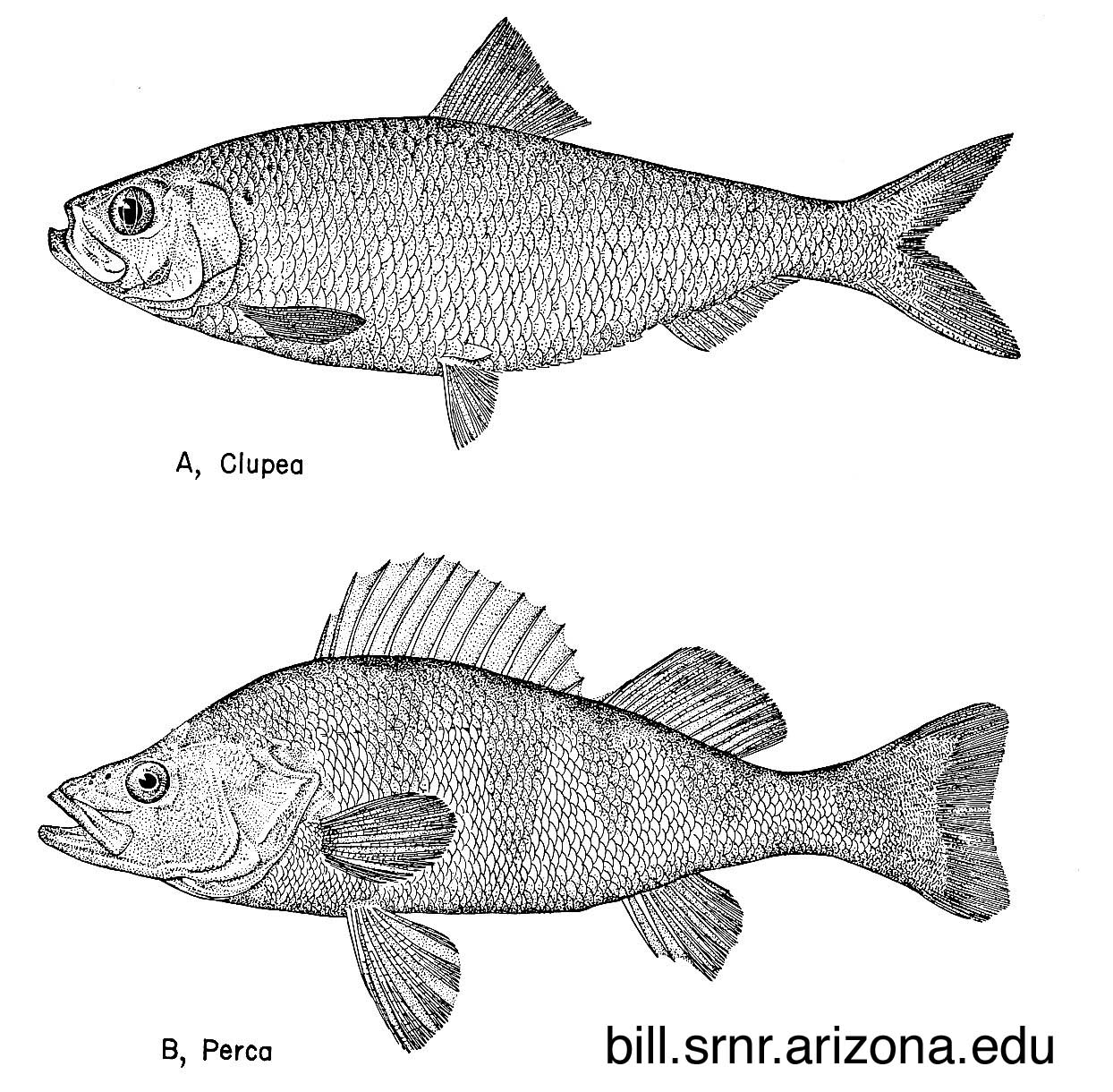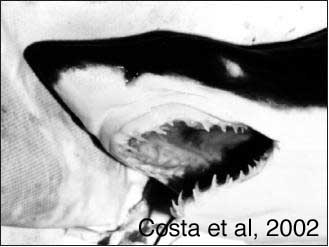Cannibalism
Biology 342 Fall 06
Oophagy and Embryophagy
Filial Cannibalism
Filial
cannibalism is the seemingly disadvantageous strategy of eating one's
own offspring, and is extremely common in teleost fish (Manica 2001). While this behavior was intially considered abnormal and the product extreme environ- mental
conditions such as food shortage (or living in a laboratory), arguments
have been made that it is in fact an "adaptive strategy to maximize
lifetime reproductive success" (Manica 2001). An interesting division within
the category of filial cannibalism in teleost fish is between whole
clutch cannibalism and partial clutch cannibalism. With the former, the
consumption of one's own offspring as a food source can only be an
investment in furture reproductive success, whereas the second
situation can contribute to the success of the current offspring as
well as future broods.
this behavior was intially considered abnormal and the product extreme environ- mental
conditions such as food shortage (or living in a laboratory), arguments
have been made that it is in fact an "adaptive strategy to maximize
lifetime reproductive success" (Manica 2001). An interesting division within
the category of filial cannibalism in teleost fish is between whole
clutch cannibalism and partial clutch cannibalism. With the former, the
consumption of one's own offspring as a food source can only be an
investment in furture reproductive success, whereas the second
situation can contribute to the success of the current offspring as
well as future broods.
 A specific example comes from the tessellated darter, Etheostoma olmstedi, and two sunfish species Lepomis auritus and Lepomis punctatus,
all of which perform filial cannibalism within their nests. However,
these nests are sometimes populated with unrelated embryos, and some
researchers have hypothesized that if these fish could destinguish between kin and
non-kin (as many other related fish can), they would choose to eat
the non-kin (heterocannibalism). DeWoody et al report evidence
contrary to this hypothesis (2001).
But why would filial cannibalism ever be
selected for? The fitness benefits must be greater than the costs
of cannibalizing one's own young. In the case of these fish, this
study
reports that even though these fish might be able to distinguish
between kin and non-kin, they
primarily eat their kin. By consuming
some of their own young they can better protect their remaining
offspring because they do not have to leave the nest to search for
other food. By sacrificing a few young, the
guarding male is able to better protect the rest of the nest. In
contrast, females are less likely to consume their young, presumably
because of their greater gametic investment. So overall, filial
cannibalism offers a selective advantage, or is at least neutral, for
the male that is consuming his young while guarding the nest
(DeWoody et al. 2001).
A specific example comes from the tessellated darter, Etheostoma olmstedi, and two sunfish species Lepomis auritus and Lepomis punctatus,
all of which perform filial cannibalism within their nests. However,
these nests are sometimes populated with unrelated embryos, and some
researchers have hypothesized that if these fish could destinguish between kin and
non-kin (as many other related fish can), they would choose to eat
the non-kin (heterocannibalism). DeWoody et al report evidence
contrary to this hypothesis (2001).
But why would filial cannibalism ever be
selected for? The fitness benefits must be greater than the costs
of cannibalizing one's own young. In the case of these fish, this
study
reports that even though these fish might be able to distinguish
between kin and non-kin, they
primarily eat their kin. By consuming
some of their own young they can better protect their remaining
offspring because they do not have to leave the nest to search for
other food. By sacrificing a few young, the
guarding male is able to better protect the rest of the nest. In
contrast, females are less likely to consume their young, presumably
because of their greater gametic investment. So overall, filial
cannibalism offers a selective advantage, or is at least neutral, for
the male that is consuming his young while guarding the nest
(DeWoody et al. 2001).
Non-filial Oophagy
Oophagy has been observed in Color-banded Ring-billed gulls in addition to infanticide. However, the infanticide of trespassing chicks is more prevalent than the stealing of unguarded eggs, so this is discussed in the Infanticide section.
Oophagy and Embryophagy
Oophagy and embryophage also occur in some sharks. All members of the Lamnoid order develop without placentation within the uterus. These embryos obtain nutrients by consuming ovules or eggs continuously produced by the mother during pregnancy. This oophagous form is derived from a lecitrophic ancestor. It has been described in 9 out of the 16 species within the Lamnoid order. One particularly unique method involves intra-uterine cannibalism (known as embryophagy or adelphophagy), but it has only been confirmed in one species (Odontaspis taurus Rafinesque).
These embryos actually have functional dentition which they use to
consume other embryos within the uterus. Functional teeth in O. taurus are
40 cm long as an embryo. In essense, these embryos are competing for
resources within the womb and only the most developed will be
born. At birth they are much larger than most other shark orders, which
is a defense mechanism to avoid predation. Even without resorting to
intra-uterine cannibalism, all oophagous species of the Lamnoid order
have a very large birth size (67-170 cm). It is possible that other
members within the order do participate in intra-uterine cannibalism
but no direct evident (presence of embryos within stomach) has been
found (Costa et al. 2002). It is important to note that intra-uterine cannibalism could
also be considered competitive cannibalism, since limited resources are
available within the uterus.
(known as embryophagy or adelphophagy), but it has only been confirmed in one species (Odontaspis taurus Rafinesque).
These embryos actually have functional dentition which they use to
consume other embryos within the uterus. Functional teeth in O. taurus are
40 cm long as an embryo. In essense, these embryos are competing for
resources within the womb and only the most developed will be
born. At birth they are much larger than most other shark orders, which
is a defense mechanism to avoid predation. Even without resorting to
intra-uterine cannibalism, all oophagous species of the Lamnoid order
have a very large birth size (67-170 cm). It is possible that other
members within the order do participate in intra-uterine cannibalism
but no direct evident (presence of embryos within stomach) has been
found (Costa et al. 2002). It is important to note that intra-uterine cannibalism could
also be considered competitive cannibalism, since limited resources are
available within the uterus.
 this behavior was intially considered abnormal and the product extreme environ- mental
conditions such as food shortage (or living in a laboratory), arguments
have been made that it is in fact an "adaptive strategy to maximize
lifetime reproductive success" (Manica 2001). An interesting division within
the category of filial cannibalism in teleost fish is between whole
clutch cannibalism and partial clutch cannibalism. With the former, the
consumption of one's own offspring as a food source can only be an
investment in furture reproductive success, whereas the second
situation can contribute to the success of the current offspring as
well as future broods.
this behavior was intially considered abnormal and the product extreme environ- mental
conditions such as food shortage (or living in a laboratory), arguments
have been made that it is in fact an "adaptive strategy to maximize
lifetime reproductive success" (Manica 2001). An interesting division within
the category of filial cannibalism in teleost fish is between whole
clutch cannibalism and partial clutch cannibalism. With the former, the
consumption of one's own offspring as a food source can only be an
investment in furture reproductive success, whereas the second
situation can contribute to the success of the current offspring as
well as future broods. A specific example comes from the tessellated darter, Etheostoma olmstedi, and two sunfish species Lepomis auritus and Lepomis punctatus,
all of which perform filial cannibalism within their nests. However,
these nests are sometimes populated with unrelated embryos, and some
researchers have hypothesized that if these fish could destinguish between kin and
non-kin (as many other related fish can), they would choose to eat
the non-kin (heterocannibalism). DeWoody et al report evidence
contrary to this hypothesis (2001).
But why would filial cannibalism ever be
selected for? The fitness benefits must be greater than the costs
of cannibalizing one's own young. In the case of these fish, this
study
reports that even though these fish might be able to distinguish
between kin and non-kin, they
primarily eat their kin. By consuming
some of their own young they can better protect their remaining
offspring because they do not have to leave the nest to search for
other food. By sacrificing a few young, the
guarding male is able to better protect the rest of the nest. In
contrast, females are less likely to consume their young, presumably
because of their greater gametic investment. So overall, filial
cannibalism offers a selective advantage, or is at least neutral, for
the male that is consuming his young while guarding the nest
(DeWoody et al. 2001).
A specific example comes from the tessellated darter, Etheostoma olmstedi, and two sunfish species Lepomis auritus and Lepomis punctatus,
all of which perform filial cannibalism within their nests. However,
these nests are sometimes populated with unrelated embryos, and some
researchers have hypothesized that if these fish could destinguish between kin and
non-kin (as many other related fish can), they would choose to eat
the non-kin (heterocannibalism). DeWoody et al report evidence
contrary to this hypothesis (2001).
But why would filial cannibalism ever be
selected for? The fitness benefits must be greater than the costs
of cannibalizing one's own young. In the case of these fish, this
study
reports that even though these fish might be able to distinguish
between kin and non-kin, they
primarily eat their kin. By consuming
some of their own young they can better protect their remaining
offspring because they do not have to leave the nest to search for
other food. By sacrificing a few young, the
guarding male is able to better protect the rest of the nest. In
contrast, females are less likely to consume their young, presumably
because of their greater gametic investment. So overall, filial
cannibalism offers a selective advantage, or is at least neutral, for
the male that is consuming his young while guarding the nest
(DeWoody et al. 2001). Non-filial Oophagy
Oophagy has been observed in Color-banded Ring-billed gulls in addition to infanticide. However, the infanticide of trespassing chicks is more prevalent than the stealing of unguarded eggs, so this is discussed in the Infanticide section.
Oophagy and Embryophagy
Oophagy and embryophage also occur in some sharks. All members of the Lamnoid order develop without placentation within the uterus. These embryos obtain nutrients by consuming ovules or eggs continuously produced by the mother during pregnancy. This oophagous form is derived from a lecitrophic ancestor. It has been described in 9 out of the 16 species within the Lamnoid order. One particularly unique method involves intra-uterine cannibalism
 (known as embryophagy or adelphophagy), but it has only been confirmed in one species (Odontaspis taurus Rafinesque).
These embryos actually have functional dentition which they use to
consume other embryos within the uterus. Functional teeth in O. taurus are
40 cm long as an embryo. In essense, these embryos are competing for
resources within the womb and only the most developed will be
born. At birth they are much larger than most other shark orders, which
is a defense mechanism to avoid predation. Even without resorting to
intra-uterine cannibalism, all oophagous species of the Lamnoid order
have a very large birth size (67-170 cm). It is possible that other
members within the order do participate in intra-uterine cannibalism
but no direct evident (presence of embryos within stomach) has been
found (Costa et al. 2002). It is important to note that intra-uterine cannibalism could
also be considered competitive cannibalism, since limited resources are
available within the uterus.
(known as embryophagy or adelphophagy), but it has only been confirmed in one species (Odontaspis taurus Rafinesque).
These embryos actually have functional dentition which they use to
consume other embryos within the uterus. Functional teeth in O. taurus are
40 cm long as an embryo. In essense, these embryos are competing for
resources within the womb and only the most developed will be
born. At birth they are much larger than most other shark orders, which
is a defense mechanism to avoid predation. Even without resorting to
intra-uterine cannibalism, all oophagous species of the Lamnoid order
have a very large birth size (67-170 cm). It is possible that other
members within the order do participate in intra-uterine cannibalism
but no direct evident (presence of embryos within stomach) has been
found (Costa et al. 2002). It is important to note that intra-uterine cannibalism could
also be considered competitive cannibalism, since limited resources are
available within the uterus. 